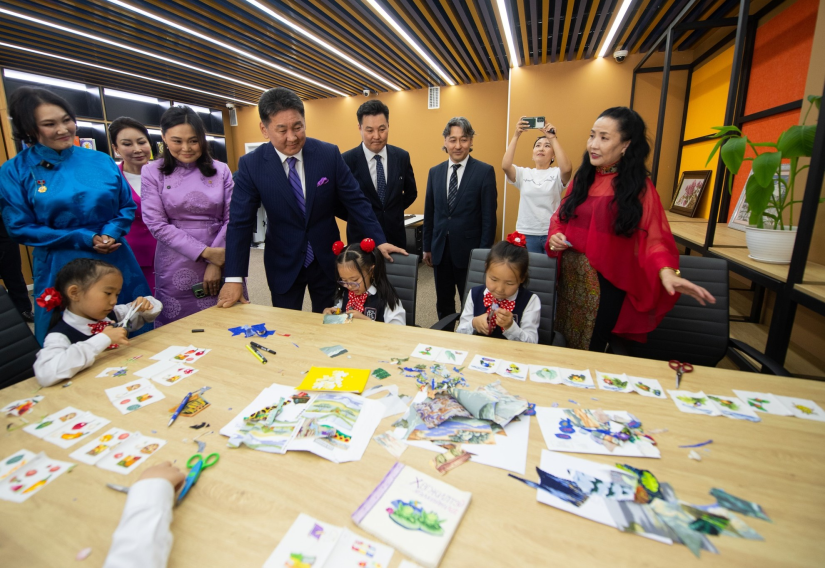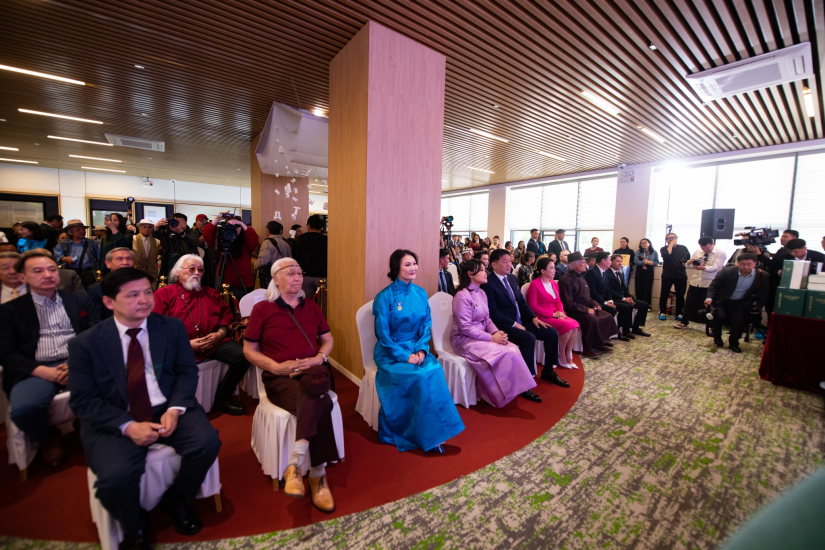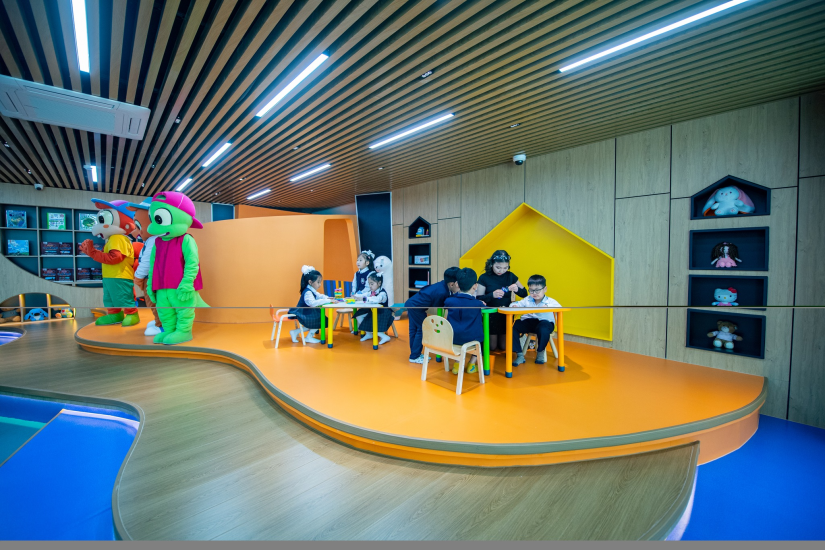Ichinkhorloo Bayarkhuu: The National Library of Mongolia is the Repository of Intellectual Heritage, and Mongol Knowledge and Wisdom
Interview
Ulaanbaatar, November 29, 2024 /MONTSAME/. MONTSAME Mongolian National News Agencys spoke with Ichinkhorloo Bayarkhuu, Director of the National Library of Mongolia.
The National Library of Mongolia has opened a new branch for the first time in its 73-year history. How are you organizing your work at the new branch?
I would like to extend my greetings to the readers of Mongolia Today. The central building of the National Library of Mongolia was opened in 1951, and this year, for the first time since then, we have commissioned our new branch.
The central building of the National Library primarily serves academic readers, focusing on individuals aged above 18. We haven’t been able to provide full services to people with physical challenges, children, mothers with young children, and the elderly. Considering all of this, we have started offering services in our new branch that we couldn't provide before. Now entire families can come and use the library together.
The new branch operates in two shifts, from 8 AM to 8 PM, and it is always full of people. Seeing the joyful faces of our visitors we, as librarians, feel accomplished and fulfilling our mission successfully. This might be the greatest joy of this autumn.
Internationally, libraries have become spaces for leisure and rest. I understand that smart technology and new trends have been integrated in your industry?
Over the past one hundred years the greatest wealth collected by our library are, first and foremost, our collection itself, and secondly, the vast intellectual benefits that flow from the library. The core of the National Library’s collection consists of ancient manuscripts and scriptures-nearly 50 percent of the collection is made up of these ancient works. This knowledge by the scholars of all times in our history represent the intellectual heritage that our library has contributed to the nation. The remaining collection, which consists of modern books and publications, reflects the scope of our services.
Now, to build the history of the next one hundred years, we are focusing on laying a solid foundation for a digital library and expanding our services beyond physical borders. Therefore, we have opened two specialized reading halls: one for academic research and one for digital access. Our Central Building holds a vast number of academic papers and theoretical materials. We now provide access to these materials through the new branch’s Academic Reading Hall, where visitors can view them digitally.
If we lay the foundation of our digital library correctly, the dissemination of scholarly knowledge to Mongolians living and working in every corner of the globe will inevitably expand.

How accessible are these manuscripts and academic works to foreign researchers, particularly Mongolists, through digital platforms?
When the new library building was constructed, there was public concern that the library might be demolished or privatized. However, we are proposing to make the National Library of Mongolia a Central Library for Worlds Mongol Studies, which holds 50 percent of its collection in ancient manuscripts, scriptures, and block-printed books. In other words, Mongolia should become the global center for Mongol Studies. The National Library of Mongolia has the collection and the facility, now, government policy and political support will have a significant impact.
We have commissioned "Altan Duulga” company to complete the design work for the renovation of the old building, and the budget has already been approved. The work of a library is never “finished” because there are no limits to human thought and intellect. Library policy should keep pace with human development, and ideally, it should even lead the way. This is the speed our times demand from us.
What sets the National Library of Mongolia apart
from other libraries around the world? How many manuscripts and scriptures are
there that have not been studied yet?
Mongolia is world-renowned for its collection of the “Ganjuur” [In the Mongolian language means “Concise Orders”- the words of Buddha in particular.] It is held in high esteem by the Mongolian Buddhists. They worship the Ganjuur at temples and recite the lines of Ganjuur in daily life as a sacred ritual], one of the main scriptures of Buddhism. Therefore, we can proudly say that the collection of the National Library of Mongolia is one of the noblest, richest, and most significant for Buddhists around the world, as well Daoists. Secondly, many people think that the Tibetan language collection consists only of Buddhist teachings. However, it preserves the intellectual treasures of the Mongolian people. For instance, our ancestors recorded many achievements in natural sciences, medical sciences, poetry, art, and culture in Tibetan. The Tibetan scriptures hold a wealth of knowledge about the characteristics of the sky, the land, water, the human body, and herbal plants. We can trace back much of our lost Mongolian traditions through these Tibetan manuscripts.
In other words, the intellectual heritage of Mongol traditions that were lost has been preserved in these Tibetan texts. The Sumbum and Ganbum [Buddhist manuscript], written by Mongolian monks, and other intellectual works by Mongolian scholars are kept in the National Library of Mongolia in Tibetan, some in Tod Script, and sometimes even in Soyombo Script. The reason why we haven't made these texts readily available to the public is that we need to study them ourselves first. We must approach the intellectual heritage of the Mongolian people carefully, systematically, and methodically. We are keen to foster Mongolian scholars who will make new discoveries from the works written by our monks, like Sumbum and Ganbum, and other Tibetan manuscripts. It is often foreigners who are more interested in studying these works than our own youth. Our ambition is to open up this vast collection to the Mongolian people and to encourage research on it.
Eventually, we will extend to an international level. As I mentioned earlier, we aim to become the Central Library for Mongol Studies. This goal involves promoting research based on our collection. We hope that scholars will be able to unlock the mystery of how Mongolia, with its small population of three million, has maintained its independence without succumbing to the influence of larger empires. For Buddhist scholars, our Tibetan manuscripts offer a great source of knowledge.

Mongolians have a history of creating manuscripts
and books using nine precious elements. The Tibetan manuscript collection is
considered as unmatched in the world. How extensive is the Tibetan manuscript
collection?
There are over a million manuscripts. However, we cannot give an exact number yet because when we unwrap a manuscript, we sometimes find four or five different texts from various periods inside, or a Cyrillic version of the Altangerel [Swrarna prabhāsa – Golden Beam] sutra. Sometimes, a beautifully written story on notebook paper appears. So, there can be multiple types of writings within a single barintag [cotton or silk cloth for wrapping the manuscript]. We count these as manuscripts because they are elements preserving Mongolian writing culture. If you ask whether they are subjects of study, the answer is yes.
The Library of Congress, a source of pride for
the world, works with the mission of acquiring the best books from around the
world. How does the National Library of Mongolia enrich its collection?
Ongud Jamiyan Sangajav Gun, along with his like-minded friends, played a historic role in building the intellectual and memory-based treasure of Mongolia. The foundation laid by the Institute of Manuscripts of Mongolia expanded into organizations like the National Archives of Mongolia, the Mongolian Language and Literature Institute, and the National Library of Mongolia, all of which have contributed to the 100-year modern history of Mongolia. The efforts of successive Heads of State and the public have been vital to enriching the National Library's collection.
We have a history of preserving Mongolia’s independence and Mongol intellectual heritage at the cost of 3,000 temples and 30,000 monks. The hidden treasures and the repository of intellectual heritage left behind by scholars and monks were gathered from family altars and even from caves and ravines. Scholars from the Academy of Sciences of Mongolia and Mongolian Language and Literature Institute played an important role in collecting these works, traveling across the country. Additionally, once the Cyrillic script became the norm, people would bring books and manuscripts they could no longer read to the National Library of Mongolia.
According to the Law on Libraries, more than three copies of every book published nationwide must be donated to the National Library of Mongolia. However, not all publishers fully comply with this provision, and the number of books received is insufficient. On top of this, we are allocated a budget of MNT 20-40 million per year to "buy books." Given the current cost of books and publications, it’s easy to see how little MNT 40 million really is. For this reason, we have organized donation campaigns annually. In recent years, the collection of the National Library has exceeded its capacity, which led to the opening of our new branch. Now, we are focused on collecting academic publications. We have signed Memorandas of Understanding with 13 institutes of the Academy of Sciences of Mongolia, ensuring that every book published by their scholars enriches our collection. The primary goal is to ensure our readers are well-served with research materials.

Mongolia now has two National Libraries. I’m sure
there are many books, manuscripts, and ancient texts you would love to exhibit.
How much more space do you think is needed to accommodate these collections?
Having two branches has made me think about opening a library in every district of Ulaanbaatar city. When the scope of services expands and more people visit the library, it brings a lot of joy and fulfillment to a professional like me. Mongolia needs happiness. It needs laughter and love. All of this can be found in the library. The library is a place where one can find peace, meet with his or her ownself, and more than just meet a book discover oneself within a book. That’s why the library is a second home for many people. It's essential to help authorities, and especially donors, understand that the library is a place of genuine humanity, morality, and intellectual service. In doing so, the private sector can share the weight with the state. We should call for libraries to be built within residential complexes, and ensure that a small book corner should always be included in the planning.
Many valuable collections that we want to show to the world are still stored in the two wings of our old library building. Based on these collections, we have the ambition to become the world’s Central Library for Mongol Studies. Our scholars and readers support this vision. Why shouldn’t we be able to become like the Library of Congress? New generations of scholars and writers, who will become our pride like Damdinsuren Tsend and Rinchen Byamba, will be born from the libraries.
The National Library of Mongolia is very much like the country itself. Just as our nation faces the challenges of being a small population under the strong influence of global culture, our library, with a limited number of readers, bears the same burden. The Mongolian language, too, stands amidst the dominance of many languages. If the country's territorial integrity is vital for its existence, the most crucial safeguard for Mongolia’s national security is its people. The primary feature that distinguishes us globally is our language. That’s why the National Library of Mongolia stands firm against the encroachment of multiple languages and cultural influences. The library holds both the intellectual treasury and the key to development, a point we keep emphasizing.
Therefore, in order to ensure that Mongolian children grow up as true Mongolians and bring them closer to the magnificent literary, historical, linguistic, and cultural heritage of our country, over 100 of our staff work tirelessly in two shifts, day, and night.
Who was the person who donated the rarest
manuscript or book in the history of the National Library of Mongolia? Could
you share some interesting historical facts that might be interesting for our
readers?
As for the donors, this tradition dates back quite far. One notable example is the Danjuur Stone Stele Monument, which is registered as part of the World Cultural Heritage. It’s a Monument that was created when the volumes of Danjuur sutras were transferred to Mongolia, and a written agreement was made. From this, we can see that the most valuable works have been entrusted to the National Library of Mongolia. Moreover, we have unique works such as the sutras offered by the Dalai Lamas, and palm-leaf manuscripts in Sanskrit script, all of which have been donated. The most recent donation was a portion of the personal library of poet Nyamaa Dolgor, a Laureate of State Premium and Honored Cultural Worker of Mongolia, donated by his children in accordance with his will. Another example is the public's participation in the “Save the History” Project, through which Barintag [cotton or silk cloth for wrapping the manuscript] are donated. As a result, our library no longer has unwrapped manuscripts, and we have preserved the tradition of binding books in the finest silk. This all was made possible thanks to the kindness of donors. It’s a reflection of the dedication of the Mongolian people who strive to keep the library alive.

For several years now, the National Book
Festivals are held at the Central Square of Ulaanbaatar city every spring and
autumn. Meeting the writers, publishers, buyers, and children attending the
event, the future of the book market of Mongolia looks promising?
The National Book Festival, first initiated by the National Library of Mongolia, is a testament of how collaboration between the public and private sectors can succeed. The initiative we began has since been carried forward by the “Nomiin Soyolt Yertunts” (World of Book Culture) NGO, turning it into a regular public event. We also have an ambition to make Ulaanbaatar the “Book Capital.” Of course, it’s hard not to view this event with optimism. At this moment, it is one of the most energetic and timely cultural events. I’m especially pleased that this celebration has expanded beyond the capital and reached provinces and districts. It’s a great way to showcase our identity as a book-loving nation to the world. Following this, private libraries have also begun to open. When people read, in one way or another, they are filling their minds and enriching their intellect with new knowledge. That’s why I wholeheartedly support and celebrate everyone who contributes to the growth of book culture and serves the true purpose of books.
You mentioned that the National Library aspires
to become the global Center for Mongol Studies. How far-fetched is this
ambition?
Let me share a story. Once, I visited Taiwan. While I was there, I expressed my wish to pay my respects to “The Secret History of the Mongols”, so I asked the staff at Taiwan’s National Library for permission. They led me through several layers of doors into a fortress-like space. An elderly man who had worked there his entire life, responsible for the Mongolian manuscripts section, was present. He opened a steel safe, and inside the safe was a white sandalwood box from which he took out “The Secret History of the Mongols”. The moment I saw it, my eyes filled up with tears-it was a profound experience. When I bowed to “The Secret History of the Mongols”, the library staff were completely astonished. They couldn’t understand why a person would bow to her own historical artifact. From that moment, they started treating me with deep respect, almost as if I were someone with magical powers. But in Mongolia, bowing to a sacred text is a common practice.
Looking at the current state of Mongolian intellect and the knowledge level of our readers, I believe this goal of becoming the global Center for Mongol Studies is not far off.
Thank you!

 Ulaanbaatar
Ulaanbaatar














































































